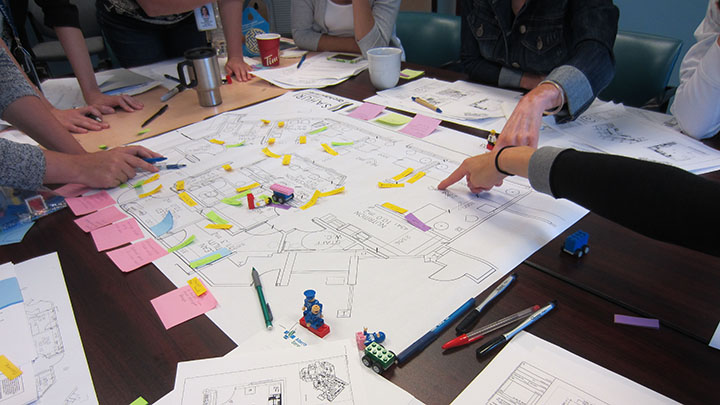
Human Factors is the scientific study of human abilities, limitations, and other characteristics. As human factors professionals, the AHS team recognizes that human error is universal and inevitable due to these variables. Consequently, the healthcare system must take a human-centered approach to mitigate and manage human error.
The goal of the AHS Human Factors Team is to improve patient safety by using human factors science to develop timely, valuable, and evidence-based solutions that reduce risk and contribute to the design of a high-quality and safe healthcare system. We strive for a healthcare system with no preventable harm.

Sub-optimal storage, signage, and/or labelling of medications and supplies on units and in pharmacies impacts the potential for errors such as mixing up numbers or look-alike medications. Human factors principles can be used to create clear and efficient solutions to make it easier for staff to prepare, select, and administer medications.
Common methods used to improve medication safety include::
Planned, newly built, and existing spaces may contain safety hazards that have not yet been identified. Evaluation of facilities, rooms, and workspaces allow for the identification and mitigation of these safety hazards. Human factors evaluations engage clinicians and patients to better understand how they will use a space and to improve the design of the space to meet their needs.
Common methods used to evaluate workspaces include:
The design of a medical device can affect the likelihood of errors occurring. Poor design impacts patient care and contributes to adverse events even when devices are used by trained, competent clinicians. A critical element of design is the usability of the device. Devices that are designed to be easy to learn, easy to use, and resilient to human error help promote safe and effective use. Human factors evaluations can help identify usability issues prior to purchase to ensure that AHS selects the safest and most clinically appropriate devices.
Common methods used to evaluate medical devices include:
When information is not designed optimally, a user’s attention can be shifted away from the content that is most critical, which can impact both efficiency and safety. The AHS human factors team works on projects to improve the design of information sources that support clinical tasks (e.g. order sets, algorithms, checklists), reference materials (e.g. posters, guides, labels, signs), and patient facing information (e.g. brochures, websites, instructions).
Common methods used to evaluate and improve the design of information include:
Due to known limitations and constraints related to human performance, human error is inevitable. However, the likelihood of human error can be reduced by modifying factors in the system or environment. Some of the factors that influence the likelihood of error are the design of the physical workspace, the design of equipment, the working environment (e.g. lighting, heating, etc.), the clarity and usability of processes and procedures, and culture. The AHS human factors team studies the causes of human error to propose systems level recommendations for risk reduction.
Common methods used to prevent human error include:
eSafety is the application of leading practices to protect patients from harm in the development, implementation, and use of digital health technology. The provision of health care is becoming increasingly tied to electronic systems such as electronic health records and clinical information systems. New technologies often raise new and unanticipated patient safety risks. It is critical that electronic systems and tools are designed with the users in mind, and tested with practitioners and patients when appropriate in order to ensure they are designed in a way that is intuitive, efficient, and safe.
Common methods used for eSafety projects: